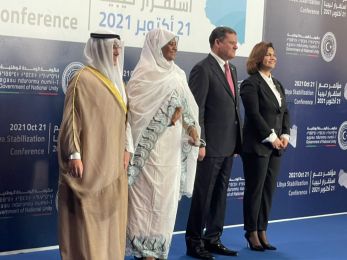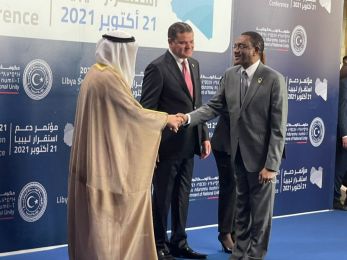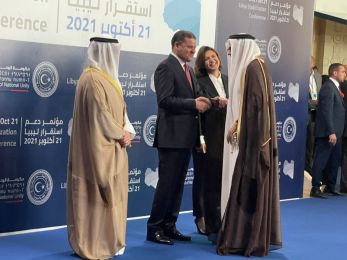PANAPRESS
Panafrican News Agency
Greenhouse gas emissions gap widening, says UNEP report
Lusaka, Zambia (PANA) – The latest Emissions Gap Report, released ahead of the UN Climate Change Conference of the Parties beginning next week in Doha, Qatar, shows that greenhouse gas emissions levels are now around 14 percent above where they need to be in 2020.
The report, coordinated by the UN Environment Programme (UNEP) and the European Climate Foundation, says action on climate change needs to be scaled-up and accelerated without delay if the world is to have a running chance of keeping a global average temperature rise below 2 degrees Celsius this century.
Instead of declining, concentration of warming gases like carbon dioxide (CO2) are actually increasing in the atmosphere -- up around 20 per cent since 2000, the report reveals, also warning that if no swift action is taken by nations, emissions are likely to be at 58 gigatonnes (Gt) in eight years’ time.
According to the report, this will leave a gap that is now bigger than it was in earlier UNEP assessments of 2010 and 2011 and is in part as a result of projected economic growth in key developing economies and a phenomenon known as ‘double counting’ of emission offsets.
Previous assessment reports have underlined that emissions need to be on average at around 44 Gt or less in 2020 to lay the path for the even bigger reductions needed at a cost that is manageable.
The Emissions Gap Report 2012 which involved 55 scientists from more than 20 countries points out that even if the most ambitious level of pledges and commitments were implemented by all countries -- and under the strictest set of rules -- there will now be a gap of 8 Gt of CO2 equivalent by 2020.
“This is 2 Gt higher than last year’s assessment with yet another year passing by.”
Preliminary economic assessments, highlighted in the new report, estimate that inaction will trigger costs likely to be at least 10 to 15 per cent higher after 2020 if the needed emission reductions are delayed into the following decades.
“There are two realities encapsulated in this report -- that bridging the gap remains do-able with existing technologies and policies; that there are many inspiring actions taking place at the national level on energy efficiency in buildings, investing in forests to avoid emissions linked with deforestation and new vehicle emissions standards alongside a remarkable growth in investment in new renewable energies worldwide, which in 2011 totaled close to US$ 260 billion,” Achim Steiner, the UN Under-Secretary General and UNEP Executive Director, stated.
“Yet the sobering fact remains that a transition to a low carbon, inclusive Green Economy is happening far too slowly and the opportunity for meeting the 44 Gt target is narrowing annually,” he added.
Steiner said while governments work to negotiate a new international climate agreement to come into effect in 2020, they urgently need to put their foot firmly on the action pedal by fulfilling financial, technology transfer and other commitments under the UN climate convention treaties.
Christiana Figueres, Executive Secretary of the UN Framework Convention on Climate Change, said, "This report is a reminder that time is running out, but that the technical means and the policy tools to allow the world to stay below a maximum 2 degrees Celsius are still available to governments and societie.
“Governments meeting in Doha for COP18 now need to urgently implement existing decisions which will allow for a swifter transition towards a low-carbon and resilient world."
Figueres added; "This notably means amending the Kyoto Protocol, developing a clear vision of how greenhouse gases can be curbed globally before and after 2020, and completing the institutions required to help developing countries green their economies and adapt, along with defining how the long-term climate finance that developing countries need can be mobilized. In addition, governments need to urgently identify how ambition can be raised."
-0- PANA MM/VAO 22Nov2012
The report, coordinated by the UN Environment Programme (UNEP) and the European Climate Foundation, says action on climate change needs to be scaled-up and accelerated without delay if the world is to have a running chance of keeping a global average temperature rise below 2 degrees Celsius this century.
Instead of declining, concentration of warming gases like carbon dioxide (CO2) are actually increasing in the atmosphere -- up around 20 per cent since 2000, the report reveals, also warning that if no swift action is taken by nations, emissions are likely to be at 58 gigatonnes (Gt) in eight years’ time.
According to the report, this will leave a gap that is now bigger than it was in earlier UNEP assessments of 2010 and 2011 and is in part as a result of projected economic growth in key developing economies and a phenomenon known as ‘double counting’ of emission offsets.
Previous assessment reports have underlined that emissions need to be on average at around 44 Gt or less in 2020 to lay the path for the even bigger reductions needed at a cost that is manageable.
The Emissions Gap Report 2012 which involved 55 scientists from more than 20 countries points out that even if the most ambitious level of pledges and commitments were implemented by all countries -- and under the strictest set of rules -- there will now be a gap of 8 Gt of CO2 equivalent by 2020.
“This is 2 Gt higher than last year’s assessment with yet another year passing by.”
Preliminary economic assessments, highlighted in the new report, estimate that inaction will trigger costs likely to be at least 10 to 15 per cent higher after 2020 if the needed emission reductions are delayed into the following decades.
“There are two realities encapsulated in this report -- that bridging the gap remains do-able with existing technologies and policies; that there are many inspiring actions taking place at the national level on energy efficiency in buildings, investing in forests to avoid emissions linked with deforestation and new vehicle emissions standards alongside a remarkable growth in investment in new renewable energies worldwide, which in 2011 totaled close to US$ 260 billion,” Achim Steiner, the UN Under-Secretary General and UNEP Executive Director, stated.
“Yet the sobering fact remains that a transition to a low carbon, inclusive Green Economy is happening far too slowly and the opportunity for meeting the 44 Gt target is narrowing annually,” he added.
Steiner said while governments work to negotiate a new international climate agreement to come into effect in 2020, they urgently need to put their foot firmly on the action pedal by fulfilling financial, technology transfer and other commitments under the UN climate convention treaties.
Christiana Figueres, Executive Secretary of the UN Framework Convention on Climate Change, said, "This report is a reminder that time is running out, but that the technical means and the policy tools to allow the world to stay below a maximum 2 degrees Celsius are still available to governments and societie.
“Governments meeting in Doha for COP18 now need to urgently implement existing decisions which will allow for a swifter transition towards a low-carbon and resilient world."
Figueres added; "This notably means amending the Kyoto Protocol, developing a clear vision of how greenhouse gases can be curbed globally before and after 2020, and completing the institutions required to help developing countries green their economies and adapt, along with defining how the long-term climate finance that developing countries need can be mobilized. In addition, governments need to urgently identify how ambition can be raised."
-0- PANA MM/VAO 22Nov2012






